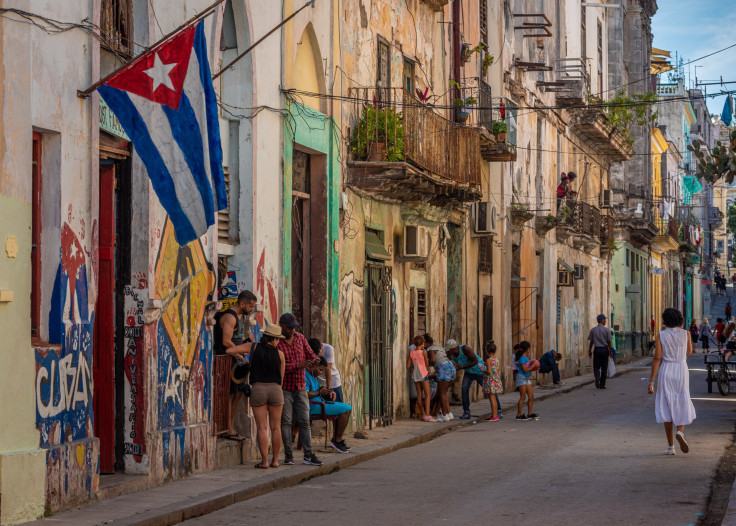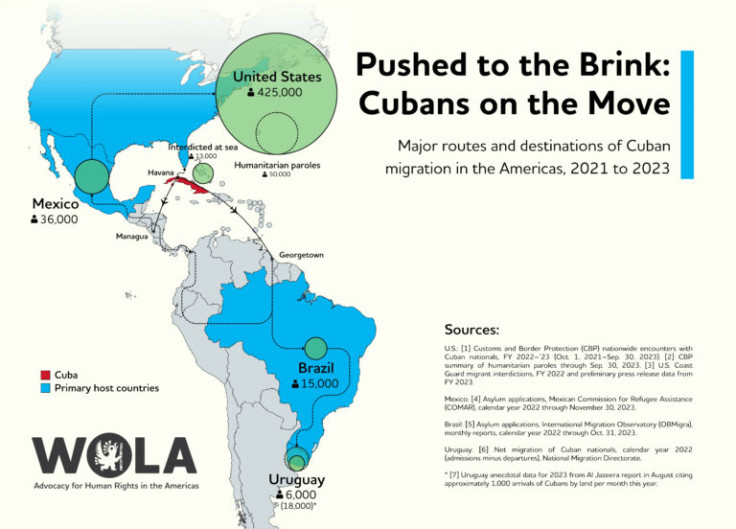
Cuba's migratory crisis has exacerbated to a point that four percent of its population left the country during fiscal year 2022-2023. Most migrants have gone to the United States, with Mexico, Brazil, Uruguay and Russia being other main destinations.
According to a report by the Washington Office on Latin America (WOLA), approximately 425,000 Cubans have sought refuge in the United States during the period. This influx, which has surpassed historical events like the 1980 Mariel boatlift and the 1994 rafter crisis combined, has prompted a series of policy responses from the Biden administration.
The initial surge, fueled by economic hardships and political discontent, led to the implementation of a humanitarian parole program in January 2023. Despite efforts to curb migration through measures such as Title 42 expulsions, late 2023 witnessed a renewed surge, driven by delayed parole processing, increased charter flights to Nicaragua, and the conclusion of Title 42.
Nicaragua's decision to drop visa requirements in November 2021 reshaped the Cuban migration landscape, creating a convenient air bridge for those seeking to bypass dangerous sea routes or going south to cross the Darién Gap.
"Once in Managua, the Ortega-Murillo government reaps profits off arbitrary entry fees before allowing smuggling networks to whisk migrants to the border with Honduras," the report explained.
In 2023 alone, an average of 50 charter flights monthly transported 100,000 people from Havana to Managua, with more than three quarters of them making their way to Honduras after.

To counter this trend, the Biden administration imposed visa restrictions for charter flights to Managua in November 2023, prompting some operators to suspend services as a result.
Moreover, the introduction of a humanitarian parole program in January 2023 aimed to reduce perilous sea crossings, and by August 2023, interdictions at sea appeared to plateau, the report says.
However, the 13,000 interdictions at sea in fiscal years 2022 and 2023 marked the largest wave since the 1994 Cuban rafter crisis. The limited availability of alternative routes raises concerns about the potential resurgence of sea crossings and their associated dangers.
As travel options to the United States dwindled due to closed doors in various countries, with transit visa restrictions and policies implemented by Costa Rica, Panama, the Dominican Republic, Jamaica, and Mexico, Guyana remained one of the few offering visa-free entry. This facilitated a direct route for Cubans hoping to reach South American countries.
"While only a few hundred Cubans passed through the Darién Gap in 2023, Guyana remains the most direct route for Cuban migrants hoping to reach Brazil and other South American countries," WOLA explained.
The mass migration from Cuba, unparalleled since the immediate aftermath of the 1959 Cuban Revolution, stems from a multidimensional crisis exacerbated by the aftermath of the COVID-19 pandemic and a policy reconfiguration under President Trump, whose administration returned Cuba to the list of state sponsors of terrorism in 2021.
Economic struggles, intensified by longstanding U.S. embargo restrictions, resulted in energy blackouts, food and fuel shortages, as well as a compromised healthcare system.
Spontaneous protests in July 2021 highlighted rising frustrations with Cuba's political system, leading to a significant brain drain, with nine percent of medical professionals leaving between 2021 and 2022.
"These points underscore that life in Cuba has become unbearable for many. In a stark recognition of the country's despair, government officials have recently warned Cubans to expect 8- to 10-hour daily blackouts, transportation disruptions, and food shortages for the foreseeable future," the report illustrates.
In response to the escalating migration crisis, the United States and Cuba engaged in high-level migration talks for the first time in four years in April 2022. Subsequent talks focused on deportation flights and visa processing, resulting in the resumption of deportation flights in April 2023. However, meaningful progress on bilateral migration accords remained elusive during the latest talks in November 2023.
Cubans arriving in the United States have traditionally benefited from the Cuban Adjustment Act of 1966, which fast-tracks permanent residency. However, recent policy changes, including the I-220A Residency Ineligibility ruling in September 2023, have complicated this process.
"Thousands of Cubans in the United States now find themselves in legal limbo. Unless overturned by a federal court or the U.S. attorney general, all immigration courts must uphold this Board of Immigration Appeals ruling," the report explains.
The report finishes by recalling that the U.S. Embassy in Havana, which suspended consular services in 2017, has gradually resumed some services. The Cuban Family Reunification Parole program, immigrant visas, and streamlined processes offer legal pathways for Cubans, addressing some migration challenges.
But the situation remains complex, with "stark forecasts of food insecurity and continued shortages underline the urgency of developing domestic policies and enacting changes to U.S. policy that address the abject suffering of the island's residents," the report concludes.
© 2025 Latin Times. All rights reserved. Do not reproduce without permission.





